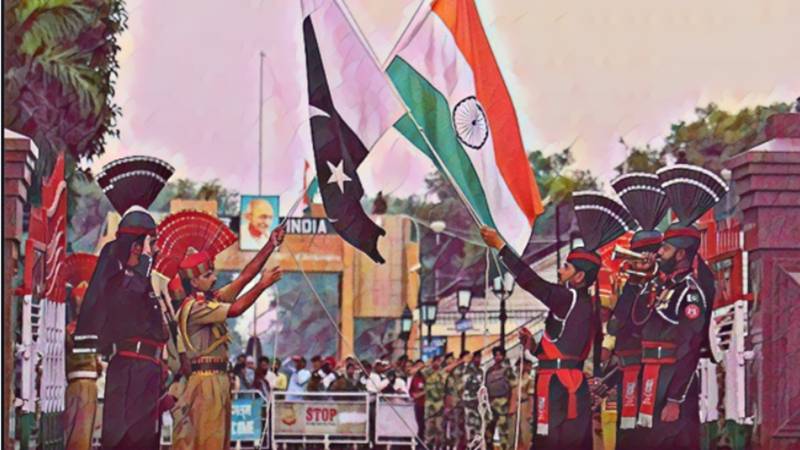
India and Pakistan, the two nuclear power countries of South Asia, are neighbours with daggers drawn since 1947. The British divided the Subcontinent on religious grounds and immediately afterwards the Kashmir issue and the deep mistrust between each other has shaped the negative attitude of the political elite on both sides. During the last 75 years, there have been three wars and countless border skirmishes between these neighbours. Fortunately there has not been a full-scale war after 1971 but there have been many scary events such as Kargil and there have been calls for peace and negotiations that have been heard on both sides of the border but nothing tangible has ever been done. The fear of attack from one another resulted in an arms race culminating in the acquisition of nuclear weapons by both countries and now the sword of a nuclear Armageddon hangs over the Subcontinent.
The history of bilateral relations between these two countries leaves a lot to be desired and very few initiatives in the past can be called serious efforts for peace. The few successful efforts that materialised are firstly the Indus Water Treaty of 1960 that resolved the water dispute, secondly the Simla agreement of 1972 that ended the bitterness of the 1971 war and brought back the 93,000 prisoners of war held by India, thirdly the 1991 agreement about not attacking each other’s nuclear installations, fourthly the composite dialogue process started in 2004. These few initiatives are a clear sign that the bilateral relations between the two countries are woefully weak and need to be improved in the interest of both the countries.
The Lahore declaration of 1999 was nullified by the Kargil adventure during the Musharraf rule. 1999 caused a serious setback to bilateral negotiations. Later on, however, another attempt – and a rather insincere effort at that – was made by both nations to resume the process of dialogue when the two leaders Musharraf and Vajpayee met at Agra in May 2000. This summit collapsed due to severe differences over Kashmir. In December 2001, the Indian Parliament was attacked by militants allegedly from Pakistan and subsequently all efforts for peace came to a grinding halt.
First of all, the dispute over Kashmir will have to be “placed on the back burner” and the initiatives to be considered are trade, student exchange, tourism (especially religious tourism), green initiative, information technology, educational and cultural exchange and cooperation in counter terrorism
In November 2008, the most serious damage to the peace process was done when non state actors or militants from a religious party attacked the Indian city of Mumbai killing hundreds of people. Those who planned and carried out the attack had only one aim and that is to destroy any chances of peace between the two countries. India had a field day and won international support and sympathy when they placed one militant called Ajmal Kasab on trial and proved that he was a Pakistani national. After the Mumbai tragedy, the leaders of both countries continued to meet in different international fora.
One meeting that attracted international attraction was the meeting between the Indian PM Man Mohan Singh and the Pakistani PM Yousaf Raza Gillani at the Non Alignment Movement summit conference in Egypt in 2009. On July 16, the two leaders met for three hours and then a joint communique was duly issued. The Indian PM reiterated the urgent need to bring the perpetrators of the Mumbai attack to justice and Gillani assured that Pakistan will do everything possible to do the same. They also agreed that the two countries would share credible information on any future terrorist threats. Gillani mentioned that Pakistan has such information about Balochistan and other areas. Both leaders expressed the need for their countries to cooperate on issues of poverty, development and regional cooperation.
The history of peace initiatives between India and Pakistan is replete with failures and setbacks but that does not mean that the peace process should be abandoned. In the word of Alexander Pope, “Hope springs eternal” – there is always hope that the two countries could one day achieve peace and harmony in their relations like the countries of the European Union or like the relations between the USA and Canada.
After all, if the 1960 Indus Water Treaty or the 1991 agreement on not attacking the nuclear installations could be signed despite the decades-long hostility and bitterness, why is a composite peace treaty beyond our two countries? The right direction to move forward is on nontraditional and nonpolitical areas to improve relations. First of all, the dispute over Kashmir will have to be “placed on the back burner” and the initiatives to be considered are trade, student exchange, tourism (especially religious tourism), green initiative, information technology, educational and cultural exchange and cooperation in counter terrorism.
The two most important countries of South Asia India and Pakistan must eliminate all impediments in the peace process because peace between them is needed for regional peace and harmony.
The decades-long confrontation between the two neighbours has led to security fears and abnormally large defence budgets. Both countries face poverty, disease, food insecurity and unemployment. The huge amounts of money used to maintain their armed forces could well be diverted to development purposes. In the post-cold war scenario of the world both countries should learn a lesson from the USSR that collapsed due to its inflated defence expenditure and continuous tensions with the USA and the European countries.
Political leaders on both sides of the border have now to make a choice between survival and extinction because any future conflict between them could result in a nuclear exchange and that could wipe out all life in the area. Even if no war takes place, the war hysteria could drive both countries towards an economic collapse due to their defence expenses and lack of sufficient investment in the economic and social spheres.

